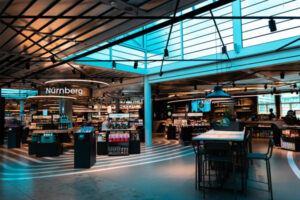By Mike Wilson-MacCormack
Many people refer to the “new normal” when talking about our adjustment to the impacts of Covid-19. However, when it comes to retail design, it is not so much about “new”, but more an acceleration of pre-existing trends. Yes, we could talk about socially distanced store layouts and touchless technology within shopping malls. To my mind, however, that misses the bigger picture, because, in many respects, the global pandemic has catapulted the retail industry further along a pathway it was already on.
The ever-increasing share of online retail and the growth of multi-channels were well underway pre-Covid-19. The events of the last months have served to catalyze and accelerate those developments, as can be seen in week-on-week growth in online retail orders – up by as much as 129% during the early days of the lockdown – across the UK and Europe. In terms of physical retail developments, in urban settings, the direction of travel will also follow what we had already begun to see. With the rapid decline of highstreets and town centers, the industry had begun to shift away from the monocultural retail model before the pandemic took hold. That is only going to continue apace post-Covid-19. With urban centers no longer able to rely solely on retail to generate footfall, they will need to become multicultural, mixed-use locations.
To that end, I expect to see increased repurposing of urban retail assets, which will flex to encompass workspace, residential, and community facilities as we move into the post-Covid-19 landscape. High streets and shopping centers will need to focus less on filling space with stock, and more on reutilizing that space for wider social and cultural needs, as well as for showrooming, fulfilment, back-of-house functions, and last-mile delivery. As Simon Forster, former Managing Director of Selfridges, recently observed: “Digital retail will satisfy the desire to purchase, but in-store it is invention, not inventory, that we will need to see from retailers.”
Essentially, as we emerge from the pandemic, we need to move away from singular, rigid, and large-format retail developments towards something more flexible, blended, and compelling. Such an approach will certainly help to reinvigorate the out-of-town retail asset class, which post-Covid-19 will depend more than ever on people having a strong reason to visit. Health centers, libraries, and pop-up workspaces could all be incorporated to create more people-focused, experienced-oriented environments. Certainly, the out-of-town retail-plus-bolt-on-leisure proposition has had its day. Post-Covid-19, without successful reimagining and meaningful re-engagement with consumers, those locations simply will not survive.
Most importantly, Covid-19 has mobilized sentiment across the board that we need to take better care of the planet. Within retail, clients and tenants are holding designers to account and demanding more sustainable solutions. From building performance to manufacture and procurement, we all have a responsibility to ensure the retail industry builds back greener from the present crisis. There is now an opportunity to deliver meaningful change. Let us make sure that we grab it with both hands.






